Dairy Cattle Management
1/115
There's no tags or description
Looks like no tags are added yet.
Name | Mastery | Learn | Test | Matching | Spaced |
|---|
No study sessions yet.
116 Terms
What does today’s dairy industry include?
dairy farmers who produce the milk, processors who provide a variety of dairy products, retailers who bring products to consumer, any of the three may be vertically integrated
What is dairying?
the science and business that deals with the production processing and marketing of milk and milk products
How many pounds of milk are produced?
226 Billion pounds
How many major dairy breeds are there?
5 major breeds
How many head of dairy cows are in the US?
9.4 million
How many dairy herds are in the US?
27,932
How many cows are there on average per herd?
337
How many pounds of milk are produced per cow per year?
24,067
How much milk does louisiana produce?
112,000 pounds
What rank is louisiana in dairy in the US?
41st
How many head of cattle are in LA?
8000 head
How many dairy herds are in LA?
70
How many cows per herd on average in LA?
133
How much milk is produced per cow per year in LA?
13,400 47th in US
What are the top 5 states for dairy total production?
california, wisconsin, idaho, new york, texas
How does supply and demand influence the number of dairy cows?
cow numbers decrease when production per cow out paces demand then cull cows sold to beef sector or cow numbers increase when demand out paces production so heifer growers supply replacement heifers
What are some factors that influence production per Cow?
improved genetics, better nutrition, better herd health, improvement in overall herd management
What is a free martin heifer?
female twin born with a bull calf usually sterile
What is a fresh cow?
has recently calved
What is silage?
fermented forage crop that is stored in a silo
What is a bulk tank?
refrigerates storage tank for harvested milk
What is DIM?
days in milk
What is SCC?
somatic cell count
What are some important features of a dairy cow?
large mammary vein, large udder carried above hock,
What are the important breeds in the US?
Ayrshire, Brown Swiss, Guernsey, Holstein, Jersey, Milking Shorthorn, Red and White (Holstein)
What is important about dairy cattle breeds in US?
selected for production of milk, combined represent at least 95% of dairy cattle in US, american angularity - refers to single purpose breeds, large body weight, large body capacity, success story
What percentage of dairy cows in US are black and white holstein variety?
86%
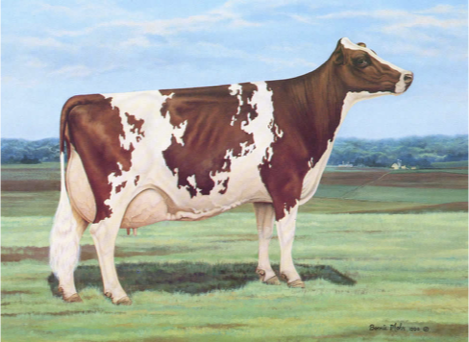
What is important about Ayrshire breed?
from Ayr county Scotland, white and red spots typically with jagged edges, medium sized (1,200), strong rugged grazers, 17,000 lbs of milk with 663 lbs fat and 561 lbs protein, convert less carotene to vit A
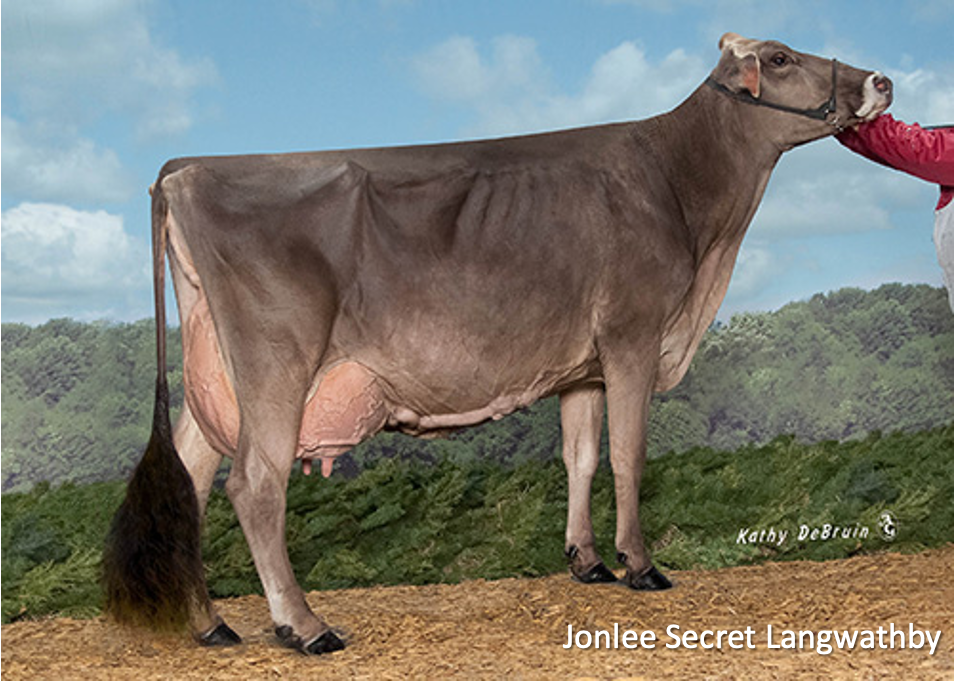
What is important about Brown Swiss?
from Swiss Alps, grey dark brown tan or almost white, large cows (1300-1500), docile, more heat tolerant, 21,000 lbs of milk with 840 lbs of fat and 735 lbs of protein
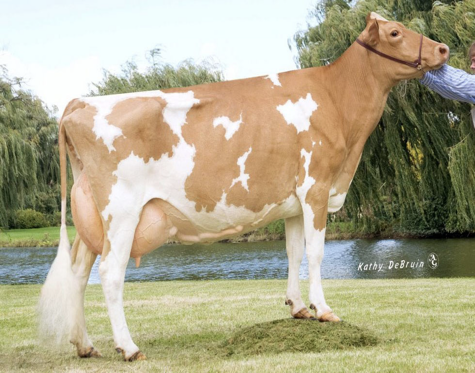
What is important about Guernsey cows?
from channel island - isle of guernsey, crosses from french breeds, intermediate body frame, high butterfat and protein milk, convert less carotene to vit A (guernsey gold), 15000 lbs of milk 675 lbs of fat and 525 lbs of protein
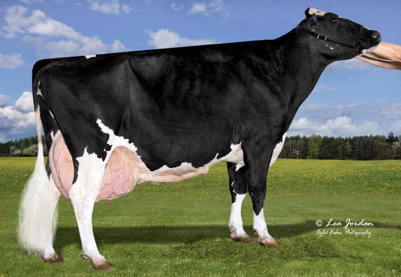
What important about Holstein cows?
originated form Batavian and Friesian cattle in netherlands, black and white, large body frame 1500 lbs 58 inches, efficient cows, 25,558 lbs milk, 946 lbs fat, 790 lbs protein in 1 yr,
Who is Selz Pralle Aftershock 3918?
holstein cow from that farm in wisconsin that produced 78,170 lbs of milk with 3,094 lbs fat and 2,393 lbs protein over 365 days
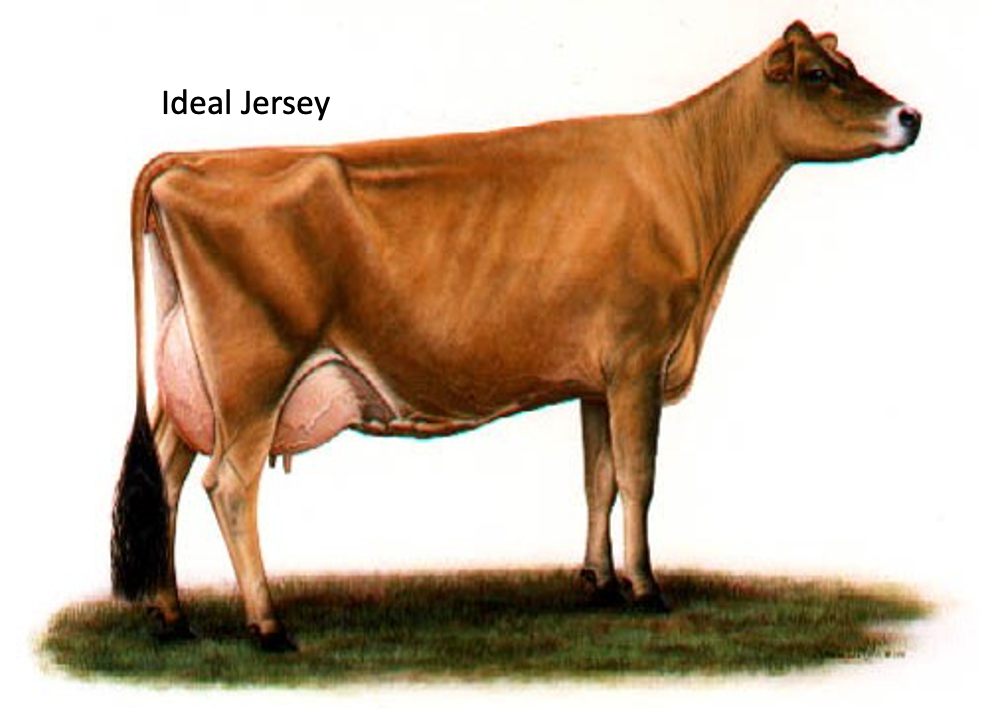
What is important about Jersey cow?
channel islands - island of jersey, crosses from frech breeds, small body frame, red red and white cream cream and white dark brown to black, high butterfat and protein milk, more heat tolerant, good grazers temperament, 18,000 lbs milk, 868 lb fat, 659 lb protein
What is important about milking shorthorn?
northeastern england, among oldest recognized breeds, medium framed red red and white white or roan, versatile breed (triple purpose) docile, recent improvements in dairy characteristics
What is dairy production labor intensive?
lots of management - nutrition, calving, calf and heifer, reproductive, milking and mastitis, cow, records
What is a day in the life of a dairy cow?
eating 3-5 hrs or 9-14 meals, lying down resting 12-14 hrs, standing or walking 2-3 hrs, drinking water 30 min, remaining 2.5-3.5 hours are herd management activities like check ups or milking routine
What are the areas of research that have improved dairy productivity?
Reproduction, herd health, nutrition, automated equipment
How has reproduction improved?
progeny testing, AI, ET, estrus and ovulation synching
How has herd health improved?
disease control, vaccines, dry cow management, mastitis prevention and control
How has nutrition improved?
efficiency, protein quality, total mixed rations, forage quality, byproducts
How has automated equipment?
milking, heat watch, feeding - robotics, today 700 hundred/hour instead of 1894 6 cows per hour
What are signs of labor?
pelvic bones widen out and tail head sinks lower into hooks of pelvis, stops to strain kick at belly lay down fidgety, aloofness, clear discharge from vulva, sides sink in belly looks larger in back than front, freshening or filling of the udder 24hrs to 3 wks before birth, loose and swollen vulva, mucous plug
What are the three stages of parturition?
stage 1- dilation of birth canal 2-6 hrs, calf rotates to upright position uterine contractions begin water sac expelled, stage 2 - delivery 1 hr cow usually laying down fetus enters birth canal front feed and head protrude first calf delivery completed, stage 3- cleaning 2-8 hrs cotyledon caruncle button attachments relax uterine contractions expel membranes
What do you do in newborn calf management?
certify calf is breathing clear mouth and nostrils from placenta, dip calfs navel in 7% iodine solution, check for umbilical hernia, ascertain calf nurses colostrum or milk and feed colostrum, separate calf from cow, identify the calf
Why is colostrum important?
quality (composition) - nutrients antibodies, Quickness (timing) -ASAP, Quantity (volume) - 2-4 quarts depends on quality
What is passive immunity?
transfer of maternal antibodies through colostrum because calf has immature immune system at birth and can’t produce antibodies this must occur within 24 hrs after birth
What is a colostrometer?
measures quality of colostrum by looking at immunoglobulins (antibodies) green 50-140, yellow 30-50, red <30
Will large volume of colostrum overcome low Lg concentration or high bacterial levels?
no it will not quality is important
What is the relationship between amount of colostrum consumed and death rate?
the more colostrum consumed the lower the death rate
What do you do if a calf won’t nurse?
try to encourage calf to suckle but if not then use esophageal feeder or stomach tube
How do you feed calves?
first 2 days colostrum, then whole milk or milk replacer at rate of 10% of birth weight, water free choice, starter grain mix first weeks, should be eating at least 2lbs/day by weaning, wean at 6-8 wks
How can you identify calves?
ear tag, neck chain, ankle band, brisket tag, picture/sketches, nose printing, tattoo ear or udder branding, temporary methods like strings sprays
What is dehorning?
purpose of horns defend itself from predators and to defend itself from other animals, disbudding should be done before 2 wks of age, pain management preferred, proper restraint, if done early less risk of infection or set back, dehorning calves up to 1 year, older calves longer recovery
What are options for dehorning by age of under 2 wks?
disbudding tube, electric dehorner, caustic paste
What are some options for dehorning before 1 yr of age?
barnes dehorner
What are some dehorning options for yearlings and older?
should be done by vet, surgical hand saw, large barnes dehorner, obstetric wire saw, guillotine, electric saw
What is scours?
it is diarrhea, with different infectious causes either bacterial, viral, protozoan parasites
What are nutritional scours?
caused by poor quality colostrum, overfeeding, irregular feeding, stress - cold damp humid overcrowding weather related
what are different types of calf housing?
hutches - good ventilation, easy to clean, place 2 feet apart on well drained area like sand or gravel, Calf housing - individual stalls - good ventilation harder to clean, Group pens- can work for some cleanliness important attention to details and sanitation are very important, older calves group housing small pasture access keep clean
What are the major areas of importance in dairy production?
records, genetics, nutrition, reproduction, herd health, cow comfort, biosecurity
What are dairy records areas of focus?
production, reproduction, udder health, culling, replacements
How has genetics helped dairy industry?
improved herd health, longevity, reproductive traits - calving ease, female fertility, increased milk production, improved milk quality, overall animal performance
What is important about BCS in dairy cows?
provides an indication of the energy status of dairy cattle from 1-5 with .25 increments one point of body condition equals 100 to 140 pounds gained in body weight
What is nutrition?
the study of the sum total of the processes involved in the ingestion and utilization of nutrients by the animal body for maintenance growth reproduction and production
What is a nutrient?
a specific element or compound derived from the ration and used to support physiological processes in the animal
What percentage of total production costs are feed costs?
40-60%
What is most closely related to profit?
feeding program
What is palatable?
will the animals eat the feed, animals select one feed over another based on smell, feel and taste
What is digestible?
how much of the feed will be absorbed as it passes through the digestive tract
What is nutritionally balanced?
Will the feed provide an adequate level of nutrients for all the production levels
What is maintenance?
existance
What is growth?
1st and 2nd lactation
What is reproduction?
last 2 months
What are the five objectives of dairy feeding programs?
Palatable, Digestible, Nutritionally Balanced, Conducive to good health, Economical
What are the six classes of nutrients?
water, protein, carbs, fats, vitamins, minerals
What is important about water?
nutrient required in the greatest quantity, clean fresh and available ad libitum need 20-40 gallons a day, intake influenced by body size, milk production because 4 gallons make 1 of milk, dry matter intake, environment, and can come in the forms of drinking in feed and metabolic
What is important about protein?
major source of amino acids which are used for growth enzymes hormones, most costly nutrient in the ration, requirements vary with age, body size, and level of production can vary 12-19% of ration dry matter
What is important about carbohydrates?
major energy source needed for muscular activity, basic metabolism, maintaining body temperature, plant tissues are high in this with starch in grains and seeds and cellulose and hemicellulose in leaves and stems
What is important about fats/lipids?
a concentrated source of energy, contain 2.25x more energy than the same amount of carbs or protein, diets of ruminants are relatively low (4-6%) as compared to diets of other farm animals, often added to diets to increase the energy density of the ration
What are important about vitamins?
wide variety but required in trace amounts, function as catalysts in various metabolic reactions, water soluble cannot be stored in body and must be supplied daily like B and C, fat soluble can be store din the body making variation in day to day intake less a problem like A D E K
What is important about minerals?
make up about 4-5% of ration dry matter, macro are expressed as % of ration dry matter (g/day) like Ca, P, Na, Cl, K, Mg, S, micro are expressed as ppm like Co, Cu, I, Fe, Mn, Se, Zn, overfeeding can cause toxicity or management problems
What is the average lactation length?
305 days
What is important about lactating cow management?
Feeding - ration balancing and forage quality, Proper milking procedures, Herd health, Reproduction
When does milk react peak production?
6-9 weeks after calving
What is the relationship between lactation and DMI?
during peak production DMI is higher than lactation then milk production decreases and DMI peaks then that pattern continues so body weight is regained and then there is a dry period
What is the phase 1 of lactation?
the first 10 weeks, when peak production occurs, and body stores are used to make up for nutrient intake deficits
What is phase 2 of lactation?
about 10 weeks postpartum until 20 weeks where intake is in balance with requirements
What is phase 3 of lactation?
intake exceeds nutrient requirements for production restoring body reserves
What is phase 4 of lactation?
a period for any final regain of body weight and involution followed by generation of secretory tissue in the udder for the next lactation aka far off dry period
What is phase 5 of lactation?
last 1-3 weeks prepartum aka close up dry period
What is the pasture based feeding system?
cows graze grass and fed concentrates in milk parlor or feed trough. Hay offered separately in hay feeder or feed bunk
What is total mixed ration system?
all ingredients forages concentrates, mixed together and offered to cows in feed trough or feed bunk
What is the target breeding age for heifers?
13-15 months
When should a heifer have her first calf?
23-25 months
What are management practices for reproduction?
artificial insemination, heat detection, synchronization protocols, methods of pregnancy diagnosis
When is puberty?
about 10 months
What is the length of estrous cycle?
21 days ± 2
What is the length estrus (heat)?
14-16 hours
When is ovulation?
10-14 hours after standing heat
What is the length of gestation?
283